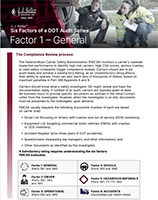Six Factors of a DOT Audit
What You Need to Know About FMCSA Compliance
FMCSA compliance audits can make or break your fleet’s operations. A Satisfactory Rating keeps your business running smoothly, while an Unsatisfactory Rating can lead to costly fines and even suspension of operations. The six factors of compliance are the key areas FMCSA evaluates during an audit. Here’s a breakdown of each factor and how to stay compliant.
Carriers must be prepared for FMCSA audits by maintaining up-to-date financial responsibility records, accident registers, and proper vehicle markings. A missing or inaccurate accident register can be seen as falsifying records—leading to severe violations. To avoid fines, ensure insurance documentation (MCS-90 or MCS-82) is valid, accident records are complete, and vehicles display USDOT markings.
Ensuring drivers meet FMCSA requirements is critical. This includes maintaining Driver Qualification (DQ) files, monitoring medical certifications, and complying with drug and alcohol testing rules. Top violations include allowing unqualified or suspended drivers to operate and failing to conduct pre-employment drug testing. To stay compliant, maintain secure DQ files, conduct random drug testing, and review motor vehicle records (MVRs) regularly.
The hours-of-service (HOS) rules are a major focus during FMCSA audits. Investigators look for log falsification, exceeding driving limits, and failure to maintain supporting documents. The most common violations involve tampering with electronic logging devices (ELDs) or failing to retain supporting documents for six months. Regular internal log audits, ELD monitoring, and fatigue management training help fleets maintain compliance.
A well-maintained fleet is essential for safety and compliance. FMCSA inspects carriers’ vehicle maintenance records, annual inspections, and roadside violations. A high out-of-service (OOS) rate (34% or more) results in a Conditional Rating. Prevent violations by implementing preventative maintenance schedules, conducting pre-trip and post-trip inspections, and using electronic maintenance tracking.
If your fleet transports hazardous materials, compliance with marking, placarding, shipping papers, and employee training is critical. Investigators check for proper documentation, security plans, and container integrity. Failure to comply can result in severe penalties or an order to cease operations. Regularly review hazmat employee training, secure storage procedures, and emergency response protocols.
FMCSA assesses a carrier’s accident record per million miles traveled. An accident rate above 1.5 per million miles for most carriers results in an Unsatisfactory Rating. Keeping an accurate accident register, properly documenting incidents, and submitting non-preventable crash appeals can help maintain compliance.

Free Resource! 6 Factors of a DOT Audit Series
Get Help Staying FMCSA Compliant!
This FREE whitepaper offers detailed insights into the key factors behind top violations. It provides actionable steps for addressing the Six Factors of Compliance and includes contact from a J. J. Keller Compliance Advisor.



